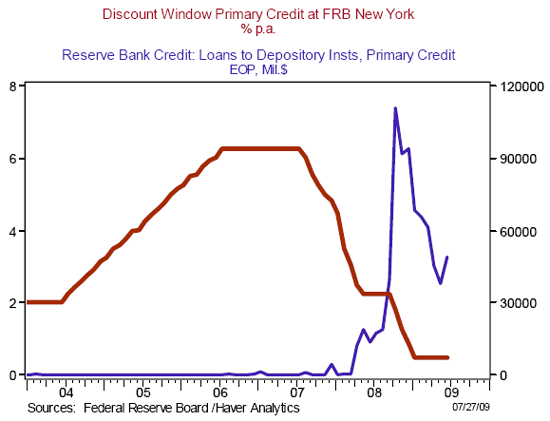This is a question I may be able to answer!
What is the discount rate?
Let’s start by going to the Federal Reserve Board’s Frequently Asked Questions website to learn what the discount rate is, and how it is changed:
The discount rate is the interest rate that an eligible depository institution is charged to borrow funds, typically for a short period, directly from a Federal Reserve Bank. By law, the board of directors of each Reserve Bank sets the discount rate independently every 14 days subject to the approval of the Board of Governors. Originally, each Reserve Bank set its discount rate to reflect the banking and credit conditions in its own District. Over the years, the transition from regional credit markets to a national credit market has gradually produced a national discount rate. As a result, the Federal Reserve maintains a uniform structure of discount rates across all Reserve Banks.
Current discount rate information is available from the Federal Reserve Board’s website. Because the timing of Reserve Bank requests to the Board of Governors may vary by a day or two, there are occasional temporary differences in the discount rates offered at Reserve Banks.
Discount Window Borrowing
Use of the Discount Window soared in late 2007 and in 2008 as deterioration in the financial sector spread and the Fed initiated a series of policy actions designed to provide liquidity to the financial system. Figure 1 shows both the interest rate on discount window loans, also known as the discount rate (thick red line), and the outstanding discount window borrowings (thin blue line) over the period from 2004 to mid-2009. On December 16, 2008, the Board of Governors set the discount rate at 50 basis points, lower than at any time during the post-World War II period. Discount window borrowing spiked to a record of almost $111 billion in October 2008 and still remained extraordinarily high in the first half of 2009.
Figure 1. Discount Rate and Discount Window Loans from 2004 to June 2009

Now, let’s get back to your question about the process and information used to change the discount rate. First, here are the steps in the process:
- The individual boards of directors of each of the twelve Federal Reserve Banks vote on discount rate recommendations.
- Requests from individual Reserve Banks to change the discount rate go to the Board of Governors of the Federal Reserve System, located in Washington, D.C., for approval.
- The Board of Governors considers the individual requests and decides what discount rate will be put into place.
- A record of the results of each Board of Governor’s decision on the discount rate recommendations is published in a Monetary Policy Release by the Board of Governors of the Federal Reserve System.
Research informing those decisions
Each of the 12 Federal Reserve Banks and the Board of Governors have a staff of research economists who monitor current economic, financial, and international conditions. At each of the Reserve Banks, economists regularly brief the Reserve Bank’s Board of Directors and the Bank president, who participates in the Federal Open Market Committee (FOMC) meetings where monetary policy decisions are made. Likewise, staff economists at the Board of Governors routinely participate in briefings and prepare materials for the Board of Governors. Therefore, as they consider discount rate policy, the Federal Reserve Bank boards of directors have access to a comprehensive and constantly updated set of information on economic conditions and financial markets as prepared by their Economic Research departments. Those materials, along with directors’ knowledge of their own industries and regions, help inform them in their discount rate recommendations.
Most of the information on the economy that Fed economists and policymakers use to make their discount rate and monetary policy decisions is publicly available. I recommend the following materials on current economic conditions and forecasts, which are available from the Board of Governors and the Federal Reserve Banks:
- Semiannual Monetary Policy Report to the Congress is presented by the Chairman of the Federal Reserve Board.
- Summary of Commentary on Current Economic Conditions by Federal Reserve District, also known as the Beige Book, is released two weeks before each FOMC meeting.
- FOMC meeting statements are released immediately after each FOMC meeting, regularly eight times a year.
- FOMC meeting minutes are released three weeks after each FOMC meeting. Starting in late 2007, every other meeting includes information on the FOMC members’ forecasts for the economy.
- FedViews is a national economic forecast prepared each month by the staff of the Federal Reserve Bank of San Francisco and posted on its website.
- The following Federal Reserve Bank of St. Louisonline publications provide up-to-date access to many of the economic indicators available to policymakers:
- National Economic Trends
- Monetary Trends
- U.S. Financial Data
- International Economic Trends
- Economic Indicators (By the Numbers) on the Federal Reserve Bank of New York website provides online information describing several key economic indicators and provides links to current data for those series.
- Federal Reserve and Other Economic Resources is a list of many important sources of information on the economy provided by the San Francisco Fed.
Additional Resources
For additional information on existing discount window programs please visit the Federal Reserve Board’s website.
For information on the Fed policy tools and lending facilities implemented in 2007 and 2008 and extended into 2009, which have extended access to the discount window beyond just depository institutions, and made credit available for longer periods than typical overnight discount window borrowing, please see the Federal Reserve Board’s monetary policy website listing of policy tools or go to the Board’s website, Credit and Liquidity Programs and the Balance Sheet. This site lists the new monetary policy tools and lending facilities.
The Federal Reserve Bank of San Francisco website provides useful links to information about the Federal Reserve System and monetary policy.